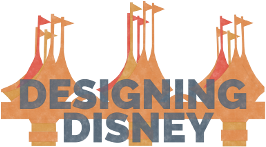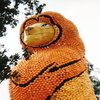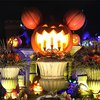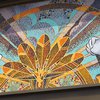Disney's America on Parade
Disney's 'America on Parade' was a colorful procession honoring the United States of America on the occasion of its bicentennial anniversary in 1975.

It was conducted at Disneyland in Southern California and Walt Disney World in central Florida. Between June 1975 and September 1976 the pageant was unfolded more then twelve hundred times and was seen by an estimated twenty-five million people.


The parade consisted of fifty units. Some of the units symbolized specific events in American history. For the most part, however, the planners concentrated on themes which, paraded in sequence, would capture the panorama of American achievements, population growth, and life-styles.


The fifty parade units took shape on the drawing boards of Walt Disney Productions.


Rough sketches became models, blueprints were made; motors were designed; the dimensions had to be adjusted to conform with the dimensions of Disneyland and Walt Disney World.

When the blueprints and models were completed and checked for accuracy and practicality, the leading manufacturers of theatrical sets in cities throughout the United States were commissioned to build the units. Every element in 'America on Parade' was manufactured in pairs, one unit for each park.

In addition, the parade featured more than one hundred and fifty doll-like characters representing the people of America. For most part the enormous animated figures on the great mobile stages were alike; the differences were drawn through costuming.

Dressing the dolls proved to be one of the most complex problems that the pageant's planners faced. First, the costumes had to be accurate. Researchers and costumers had to work together to find appropriate fabrics, and to sew them as they would have been sewn, fifty, a hundred, two hundred years ago.

But that wasn't all: the material had to be bright enough to be seen clearly in the parade, tough enough to withstand the wear of the six hundred outdoor performances, and practical enough to be cleaned quickly, easily, frequently.

And if that didn't complicate things enough, there was the weight problem to worry about. For inside each of the eight foot dolls would be a teenage boy or girl who would have to perform with considerable energy under the very hot sun of Florida or California; therefore the fabric had to be lightweight.

Next the dolls were given appropriate wigs, hats and props - all of which had to meet the same requirements met by the costumes.

The Disney organization designed the parade units to look like huge toys, and the characters to be outsized dolls. The size of the show made the presentation easily visible. Visibility, however, was only one reason for the gigantic scale...
For, like every aspect of the production, the bigness of the parade units and characters contributed to the celebratory atmosphere - an atmosphere calculated to make everyone, old as well as young, see the parade through the eyes of a child.
American musical history provided researchers with more than enough songs for the parade, but the means to play those songs represented a problem. The planners wanted a band-organ sound, and two years before the start of the pageant they began a search for a real mechanical music box to play the selected songs.

Eventually they found a completely restored 1890 band organ - in Sikeston, Missouri. Known as 'Sadie Mae', the instrument had some two hundred pipes and worked on the same principle as a player piano, except the punched-hole piano books were used in stead of piano rolls.

That was fine - except that the researchers found out that only one man in the world was capable of making piano books by hand, and he was in Belgium. Determined to settle for nothing less than Sadie Mae, Disney sent the musical arrangements to Belgium and had the books made.

Then Sadie Mae was taken apart and shipped to Nashville, where it was reconstructed in a one of that city's many recording studios and given the new books to play. The tapes made in Nashville were sent to Los Angeles, where, still in another recording studio, Sadie Mae's music was embellished with the sounds of a moog synthesizer.
To make the most of the recorded music, the Disney engineers devised a system whereby selected units broadcast from their own loudspeakers while others broadcast their signals to radio receivers along the parade route; then the signals were re broadcasted through loudspeakers in fixed locations.
The radio-transmitted signals and the signals broadcasted from the units themselves were perfectly synchronized, and made music that was almost symphonic in its constancy and pacing.

At the conclusion of the parade, the recorded strains of Sadie Mae were mixed with melodies played by a live band. Inasmuch as each state in the union was honored during a specific week of the fifteen-month celebration, the Disney organization had invited marching bands - most of which were from high schools - to participate in 'America on Parade'.

Disney's 'America on Parade' was presented once a day during the winter months, and twice day during the summer weekends and on holidays. The second performance in the twice-a-day program was held at night, and was followed by an astonishing fireworks display.






